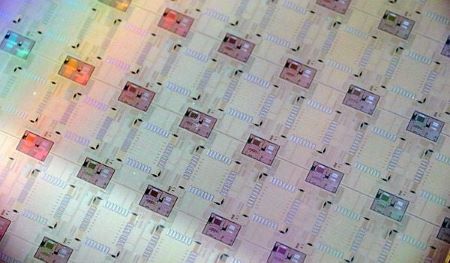



Lightmatter, a startup formed by three MIT alumni, is making significant progress in developing light-based solutions for advanced computing. The company's Passage chip utilizes the speed and bandwidth benefits of light, similar to fiber optic cables, to enable efficient processor interconnection. This breakthrough technology has the potential to revolutionize the communication methods among chips and the techniques for conducting AI calculations. Lightmatter's Envise chip combines the computing abilities of electrons with the photonics capabilities, enabling simultaneous calculations in different light hues. The Passage chip links processors using light, allowing chips to function as a single processor as large as entire wafers. Lightmatter is also focused on boosting computing's energy efficiency to meet growing demand without significantly increasing power usage. The company is collaborating with cloud service providers and chip manufacturers for widespread implementation. Lightmatter's objective is to develop the next generation of computers centered around the utilization of light [4b07270c].
This development in light-based solutions for advanced computing aligns with the broader trend of exploring innovative technologies to enhance computing capabilities. Lightmatter's breakthrough technology has the potential to address the limitations of traditional electronic-based computing systems and pave the way for more efficient and powerful processors. By leveraging the speed and bandwidth advantages of light, Lightmatter aims to overcome the communication bottlenecks and enable faster and more efficient data transfer among chips. The collaboration with cloud service providers and chip manufacturers indicates the industry's recognition of the potential of light-based computing and the commitment to driving its widespread adoption [4b07270c].
In a related development, TeraSignal has announced the TS8401/02 intelligent 400G (4x100G) PAM4 modulator driver, the industry's first CMOS solution with digital link training and link monitoring for 800G linear pluggable optical (LPO) modules. The driver addresses the limitations of traditional LPO modules by introducing automatic adaptation, digital link monitoring, and link training. It reduces power consumption by up to 50% compared to existing solutions and improves link reliability and performance. TeraSignal is now shipping samples of the TS8401 and TS8402 re-drivers to early access customers and partners [228fc463].
The introduction of CMOS intelligent re-drivers by TeraSignal represents a significant advancement in AI and compute interconnects. These intelligent re-drivers offer digital link training and link monitoring capabilities, enabling automatic adaptation and improving link reliability and performance. The CMOS solution reduces power consumption by up to 50% compared to existing solutions, making it more energy-efficient. TeraSignal's shipment of samples to early access customers and partners indicates the readiness of the technology for implementation [228fc463].
Adtran and Vertilas have also made significant progress in the field of AI solutions with their development of the industry's first 100Gbit/s PAM4 single-mode vertical-cavity surface-emitting laser (VCSEL) technology. This technology, with capabilities up to 1.6Tbit/s, sets new standards for low power consumption in optical engines and modules. It achieves up to 80% reduction in power on the transmit optics compared to conventional solutions. The technology is tailored for intra-data center operations and AI/ML workloads, achieving efficiency of less than 2pJ/bit. Based on indium phosphide semiconductor material, it operates across both O-band and C-band wavelengths, supporting throughput of 800Gbit/s and 1.6Tbit/s, with power consumption below 200mW per lane. Adtran's MicroMux family of small-form-factor pluggable transceivers will benefit from this advancement. The technology addresses the demand for high-capacity and environmentally friendly data processing solutions for generative AI applications [12c4cd5b].
Lightwave Logic, Inc. has been granted a new U.S. patent that enhances the stability and performance of its proprietary materials used in datacenter applications. The patent covers the company's latest innovation in nonlinear optical chromophores with diamondoid groups. The technology is expected to improve the durability of polymer materials in optical modulators, crucial components in data transmission. Lightwave Logic envisions this material as a fundamental element for future 800Gbps and 1600Gbps optical transceiver modules. The patented chromophores, integrated with diamondoid molecular groups, have shown improved electro-optic properties and increased poling efficiency. The materials are also compatible with high-volume manufacturing processes in silicon foundries. Lightwave Logic focuses on engineered electro-optic polymers for faster data transmission with lower power consumption [9589dd8e].
Stanford researchers have developed a chip-scale Titanium-sapphire (Ti:sapphire) laser that is 10,000 times smaller and 1,000 times cheaper than previous models. This breakthrough in miniaturization and cost reduction could democratize the use of Ti:sapphire lasers, making them accessible to a wider range of applications. The chip-scale lasers are efficient and portable, and can be produced on a chip at low cost without compromising performance. The potential applications for this technology include quantum computing, neuroscience, optogenetics, and ophthalmology. The next steps for the researchers include perfecting the chip-scale lasers and developing methods for mass production. This innovation marks a new era where high-performance Ti:sapphire lasers are available for broader use, enabling advancements that were previously unattainable [1b20bed2].